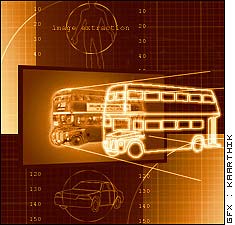Here you can find a summary of innovations in the fields of information and data processing and up-to-date developments on IT equipment and hardware.
This area covers topics such as IT services, IT architectures, IT management and telecommunications.

A new class of microscopic crystal structures developed at the University of Toronto is bringing high bandwidth optical microchips one step closer to efficient, large-scale fabrication. The structures, known as photonic band gap (PBG) materials, could usher in an era of speedy computer and telecommunications networks that use light instead of electrons.
“This will be a tremendous breakthrough,” says Sajeev John, a professor in U of T’s Department of Physics and co-investigator of the st

Scientists and computer gamers alike could benefit from a new method for creating soft, realistic shadows in computer-generated images.
Engineers at Ohio State University have created computer algorithms that model how light passes through translucent three-dimensional objects or fluids such as water, clouds, fire, and smoke. The result: shadows that begin to approach the realism of Hollywood animation, but don’t require as much computer memory to create.
Caixia Zhang, now a

A research team at the University of California at Santa Barbara (UCSB) has for the first time incorporated on a single chip both a widely tunable laser and an all-optical wavelength converter, thereby creating an integrated photonic circuit for transcribing data from one color of light to another. Such a device is key to realizing an all-optical network. This research is being funded by a Defense Advanced Research Project Agency (DARPA) Microsystems Technology Office (MTO) grant to push the boundary

Inflation’s got nothing to do with it. Since the beginning of time, a picture has always been worth more than a thousand words. But in this age of information proliferation, that reality is the taproot of a vexing problem that Zhongfei “Mark” Zhang, an assistant professor of computer science at Binghamton University, is determined to help solve.
From personal and commercial digital image libraries and multimedia databases to data mining programs and high-tech security and defense survei

Addressing the market demand for ever greater reach for VDSL and ever greater bandwidth over a single pair, Infineon Technologies (FSE/NYSE: IFX) and Metalink (Nasdaq: MTLK), today announced they are each developing VDSLPlus, which introduces a fifth-band extension of standard VDSL technology. VDSLPlus will enable service providers to offer scalable DSL services ranging from short range applications at data rates up to 150 Megabits per second (Mbps), to long reach applications that allow for more

Infineon Technologies (FSE/NYSE: IFX) and Clariant Corporation’s AZ Electronic Materials business (Somerville, N.J., USA) have signed an agreement to jointly develop photoresists for 157 nm exposure technology. The goal is to accelerate qualification of this technology for volume production.
The photoresist materials to be developed in this project will specifically enable Infineon to qualify the 157 nm technology for producing 55 nm structures in DRAM (dynamic random access memory)